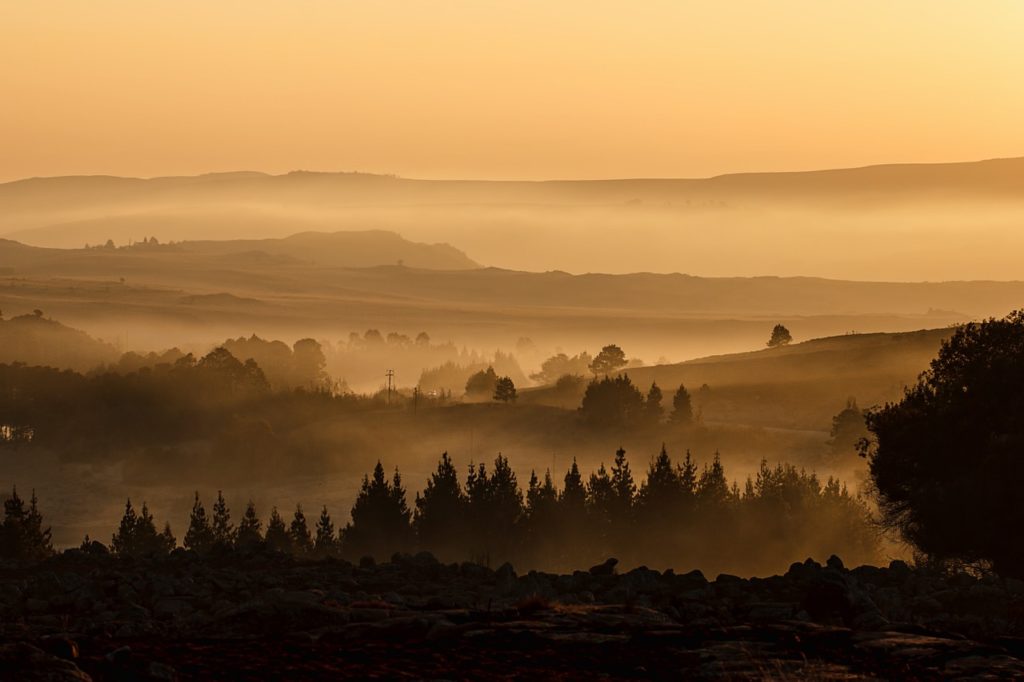Watercolor effect in vector landscape design

A landscape is the visible features of an area of land, its landforms and how they integrate with natural or man-made features.
A landscape includes the physical elements of geophysically defined landforms such as (ice-capped) mountains, hills, water bodies such as rivers, lakes, ponds and the sea, living elements of land cover including indigenous vegetation, human elements including different forms of land use, buildings and structures, and transitory elements such as lighting and weather conditions.
Combining both their physical origins and the cultural overlay of human presence, often created over millennia, landscapes reflect a living synthesis of people and place that is vital to local and national identity.
The character of a landscape helps define the self-image of the people who inhabit it and a sense of place that differentiates one region from other regions.
It is the dynamic backdrop to people’s lives. Landscape can be as varied as farmland, a landscape park, or wilderness.
The Earth has a vast range of landscapes, including the icy landscapes of polar regions, mountainous landscapes, vast arid desert landscapes, islands and coastal landscapes, densely forested or wooded landscapes including past boreal forests and tropical rainforests, and agricultural landscapes of temperate and tropical regions.
The activity of modifying the visible features of an area of land is referred to as landscaping.
Definition and etymology
There are several definitions of what constitutes a landscape, depending on context. In common usage however, a landscape refers either to all the visible features of an area of land (usually rural), often considered in terms of aesthetic appeal, or to a pictorial representation of an area of countryside, specifically within the genre of landscape painting.

When people deliberately improve the aesthetic appearance of a piece of land—by changing contours and vegetation, etc.—it is said to have been landscaped, though the result may not constitute a landscape according to some definitions.
There are several words that are frequently associated with the word landscape:
- Scenery: The natural features of a landscape considered in terms of their appearance, esp. when picturesque: spectacular views of mountain scenery.
- Setting: In works of narrative (especially fictional), it includes the historical moment in time and geographic location in which a story takes place, and helps initiate the main backdrop and mood for a story.
- Picturesque: The word literally means “in the manner of a picture; fit to be made into a picture”, and used as early as 1703 (Oxford English Dictionary), and derived from an Italian term pittoresco, “in the manner of a painter”.
- A view: “A sight or prospect of some landscape or extended scene; an extent or area covered by the eye from one point” (OED).
- Wilderness: An uncultivated, uninhabited, and inhospitable region.
- Cityscape (also townscape): The urban equivalent of a landscape. In the visual arts a cityscape (urban landscape) is an artistic representation, such as a painting, drawing, print or photograph, of the physical aspects of a city or urban area.
- Seascape: A photograph, painting, or other work of art which depicts the sea, in other words an example of marine art.
Physical landscape
Geomorphology is the scientific study of the origin and evolution of topographic and bathymetric features created by physical or chemical processes operating at or near Earth’s surface.
Geomorphologists seek to understand why landscapes look the way they do, to understand landform history and dynamics and to predict changes through a combination of field observations, physical experiments and numerical modeling.
Geomorphology is practiced within physical geography, geology, geodesy, engineering geology, archaeology and geotechnical engineering. This broad base of interests contributes to many research styles and interests within the field.
